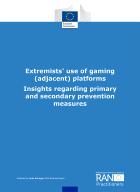Details
- Publication date
- 21 September 2021
- Author
- Directorate-General for Migration and Home Affairs
- RAN Publications Topic
- Internet and radicalisation
Description
In recent years, particularly since the 2019 livestreamed attack in Christchurch, New Zealand, video games, gamer communities, and online plattforms made for gaming and related activities, have moved to the center of attention of policy, practice, and academia working on preventing and countering (violent) extremism (P/CVE).
The EU Counter-Terrorism Coordinator recently warned of the potential digital gaming environments hold in supporting various terrorist and extremist activities, including the radicalisation of young people. The Radicalisation Awareness Network (RAN) has classified gaming (adjacent) platforms as ‘hotbeds’ for radicalisation. Similarly, the 2021 EU Terrorism Situation and Trend Report (TE-SAT) details that both video games and gaming platforms are increasingly used to propagate extremist ideology and disseminate propaganda, especially by right-wing extremist actors.
TE-SAT also warns that the COVID-19 pandemic and the subsequent increase in screentime contributed to a rise in opportunities for extremist actors to make contact with young people through gaming (adjacent) platforms.3 It is believed that extremist actors seek to “capitalise on the massive, youthful audience and the gaming world’s deep integration within pop culture.” 4 A recent RAN conclusion paper presented a typology of six ways gaming-related content can be used by extremist actors to further their goals.
These included: production of video games, the modification of existing games, the use of in-game chat functions, the use of gaming (adjacent) platforms, gaming cultural references, and gamification.5 The following paper is focused on the gaming (adjacent) platforms. However, it should be noted from the outset that the content posted on such platforms is often built on gaming cultural references and therefore both types overlap to some degree in the discussion that follows. The first part of the paper discusses how traditional gaming (adjacent) platforms have contributed to extremist activities.
Non-gaming platforms must be considered in addition to classic platforms focused on gaming. The paper will also explore how extremist individuals and organisations make strategic and organic use of the platforms. The second part focuses on opportunities for primary and secondary prevention on gaming (adjacent) platforms. As there is little experience of P/CVE measures on these platforms, the paper provides considerations and recommendations that should be taken into account when designing and implementing prevention efforts in these environments.

